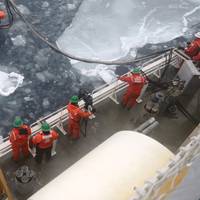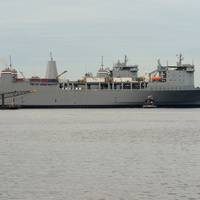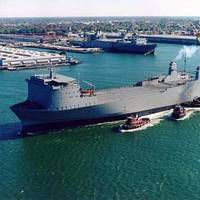New Plan Pledges Ferry Safety Lead

Interferry has unveiled a strategic plan promising to put safety issues at the heart of its work as the voice of the worldwide ferry industry. The pledge came at the global trade association’s 41st annual conference in Manila – a venue chosen to spotlight the challenges of domestic ferry safety in developing nations. According to Interferry, the plan signals its overriding ambition to help lift ferry safety in all parts of the world to the very high standard already in place in North America and Europe, where casualties in recent decades have been extremely rare.
Oil Under Ice

The U.S. How did an urgent requirement to build a road to Alaska end up helping to design submarines and to recover oil spills in the Arctic ice? The Army Corps of Engineers was faced with a monumental challenge of building a highway to connect the “lower 48” to Alaska during World War II to keep America’s northernmost territory secure from invasion. The road crossed hundreds of miles of wilderness, and much of the roadbed sat up permafrost, presenting challenges to America’s roadbuilders.
Syrian Chemical Weapon Neutralization: Final Stage
One of the final phases in the dismantling of Syrian chemical arsenal has been completed at the Italian southern port of Gioia Tauro, according to multiple media reports. It took about 12 hours to tranship the 78 containers holding some 560 metric tons of chemicals that had been loaded aboard the Danish cargo ship Ark Futura at the Syrian port of Latakia to USNS Cape Ray. The Cape Ray is specially equipped with two field-deployable hydrolysis systems capable of neutralizing the chemical agents, and is heading for international waters to complete the mission. Pictured: transfer of a container from MV Ark Futura, to USNS Cape Ray at the Medcenter Container Terminal.
US Navy Ship En Route to Receive Syrian Chemical Weapons

U.S. motor vessel Cape Ray departed Rota, Spain, this morning en route to the port of Gioia Tauro, Italy, where the ship will receive declared Syrian chemical weapons transferred from the Danish vessel Ark Futura, the U.S. Navy announced today in a press release. In a statement announcing the departure, Pentagon Press Secretary Navy Rear Adm. John Kirby said the transit to Italy is expected to take several days. After the transfer is complete, the Cape Ray will depart Gioia Tauro…
US Cargo Ship to Load Syrian Chemical Agents Soon
An American cargo ship, the 'Cape Ray' converted into a mobile chemical weapons destroyer is expected to take charge of some of Syria's most dangerous materials next week, a U.S. defense official said. Syria on Monday handed over the remaining 8 percent of a total 1,300 tonnes that Syria declared to the Organisation for the Prohibition of Chemical Weapons (OPCW). The handover had faced repeated delays, leaving the Cape Ray docked in southern Spain awaiting a green light to proceed. Its mission now is to transform toxic agents into a much less poisonous soup of chemicals, ready for disposal back on land. The Cape Ray's crew were given word on Monday that they needed to be ready to depart Spain in the coming days for southern Italy's Gioia Tauro port…
Ship Ready to Destroy Syria's Chemical Arms at Sea

Experts on board a cargo ship transformed into a multimillion dollar chemical weapons destroyer said on Thursday they were ready to start working on Syria's stock of toxic arms in the middle of the Mediterranean as early as May. Now they just have to hope the weather holds and Damascus delivers on time. Former container vessel Cape Ray, docked in southern Spain, has been fitted out with at least $10 million of gear to let it take on about 560 metric tonnes of Syria's most dangerous chemical agents and sail them out to sea, said officials.
Syrian Chemical Arsenal Due for Italian Port Ship-to-Ship Transfer

The transfer of some 500 tons of Syria's chemical agents to the US special purpose vessel 'MV Cape Ray' will take place in the port of Gioia Tauro, reports Xinhua, citing a hearing before the Italian parliamentary commissions of foreign affairs and defence. The Syrian chemical arsenal aboard the Danish cargo vessel will be directly transfered to the U.S. ship MV Cape Ray through 60 containers and special equipment, and citing Minister of Infrastructure and Transport Maurizio Lupi…
LNG: Now Powering Vessels – and New Safety Regulations
New Hazards, New Regulatory Concerns and New Solutions. According to global classification society DNV, as much as 50 percent of the world’s maritime fleet could be duel fuel-powered, as early as 2020. The lure of LNG is understandable – cleaner burning fuels, potentially lower maintenance costs, better efficiencies and lower fuel cost all can counted amongst the growing reasons to take the leap. But, owner/operators considering LNG to power vessels must understand the fire hazards present, the various fire protection solutions and the codes that regulate them. In the rapidly emerging LNG market, it’s important for ship owners and builders to understand just how different fire safety standards are for LNG ships versus diesel.
MECO Wins USN Shipboard Desalination Contract
MECO won the design and development of advanced shipboard desalination units for the US Navy under contracts with the Office of Naval Research (ONR). Under the new contracts, MECO will develop systems rated at 4000 and 100,000 gallons per day that are designed to take advantage of advancements in technology and function within the constraints of operating on naval ships. The program will span three years with the first six months spent in design followed by development of demonstration prototypes. Objectives of the program include minimizing volume, mass and manning requirements while improving reliability. In conjunction with Teledyne Scientific and DARPA, MECO is developing technologies to further reduce weight, space and energy for man portable desalination.
Disposal of Chemical Weapons at Sea
While World War II is well-known as the beginning of the age of atomic weapons, World War I is lesser-known as dawn of the age of chemical weapons. The 1914-1918 conflict saw development and large-scale production of mustard gas, lewisite, and other chemical agents specially designed and packaged for use in armed conflict. With the armistice ending the War to End All Wars, large quantities of this material was left with no place to go. The technology to safely destroy these chemical weapons did not exist and public concern over its existence was largely nil. Without giving the matter much thought, the victorious Allies took much of the surplus chemical weapons out to sea and dumped it overboard.
Pakistan Navy Adds to Fleet
The inventory of Pakistan Navy is being strengthened while measures are being taken to make the navy a potent force, defense experts have said. Last year, the Pakistan Navy inked a deal with China for four state-of-the-art frigates besides inducting modern Agosta 90b submarines and enhancing the existing fleet of P-3C Orion surveillance aircrafts. The acquisition of four F-22P frigates would be an important step for the county’s maritime defence and experts hope that the first of the ships would be delivered in 2008. According to schedule, China State Shipbuilding Corporation would supply the ships from 2008 to 2013. The fourth warship would be built completely in Pakistan to transfer the technology.









